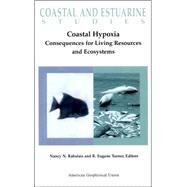Coastal Hypoxia Consequences for Living Resources and Ecosystems
, by Rabalais, Nancy N.; Turner, R. Eugene- ISBN: 9780875902722 | 0875902723
- Cover: Hardcover
- Copyright: 1/9/2001
Published by the American Geophysical Union as part of the Coastal and Estuarine Studies, Volume 58.
Hypoxia is a condition that occurs when dissolved oxygen falls below the level necessary to sustain most animal life. In U.S. coastal waters, and in the entire western Atlantic, we find the largest hypoxic zone in the northern Gulf of Mexico on the Louisiana/Texas continental shelf. The area affected, which is about the size of the state of New Jersey at its maximal extent, has increased since regular measurements began in 1985. Sediment cores from the hypoxic zone also show that algal production and deposition, as well as oxygen stress, were much lower earlier in the 190Os and that significant increases occurred in the latter half of the twentieth century. We publish this book against the background of such measurements, and to review how the developing and expanding hypoxic zone has affected living resources on this continental shelf.







